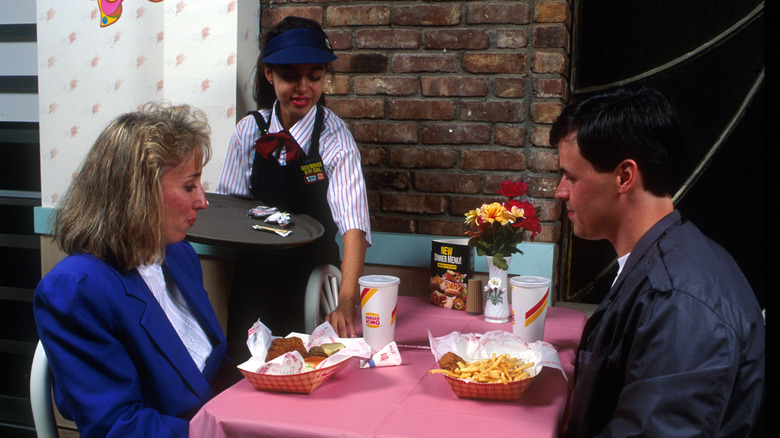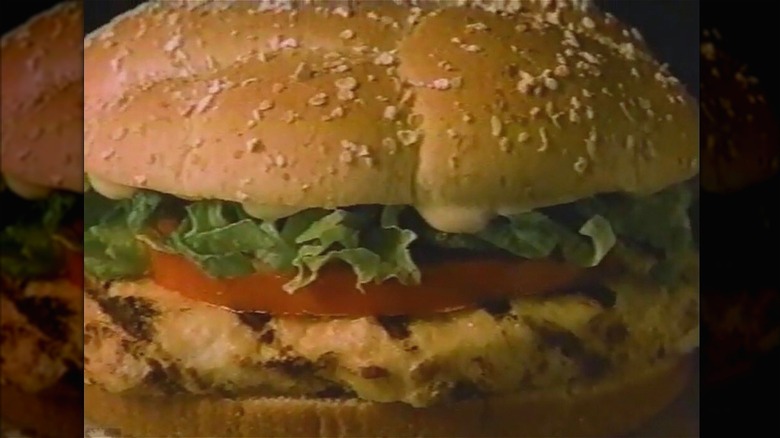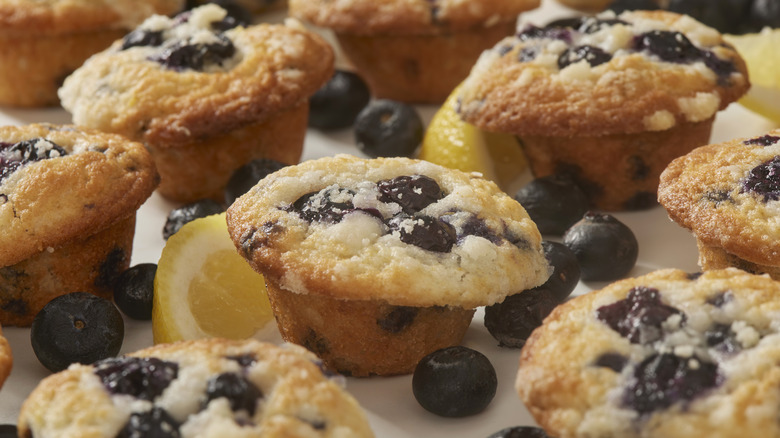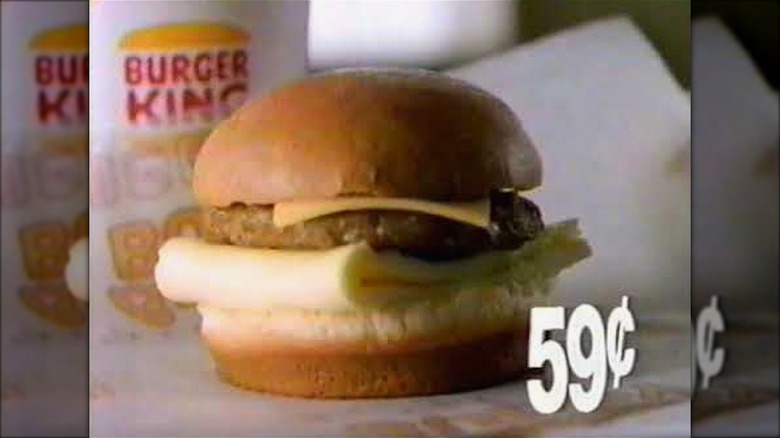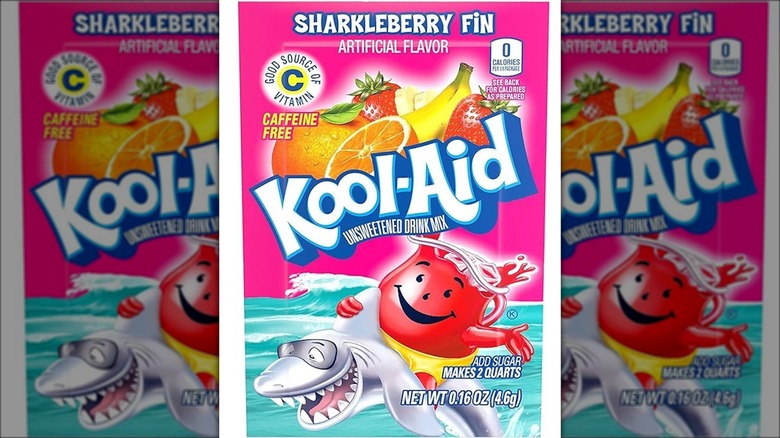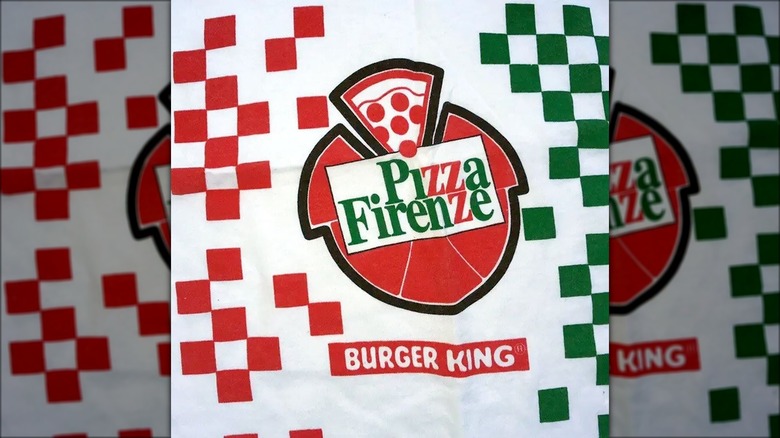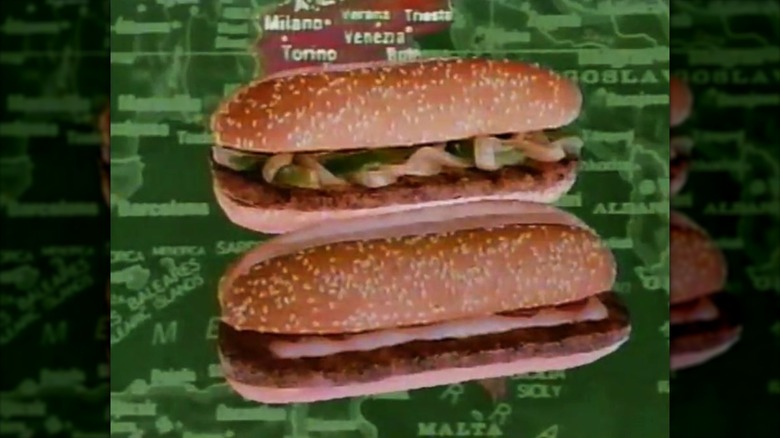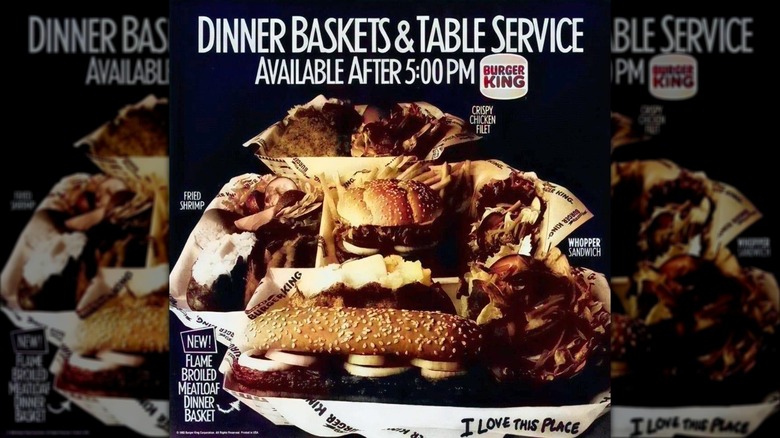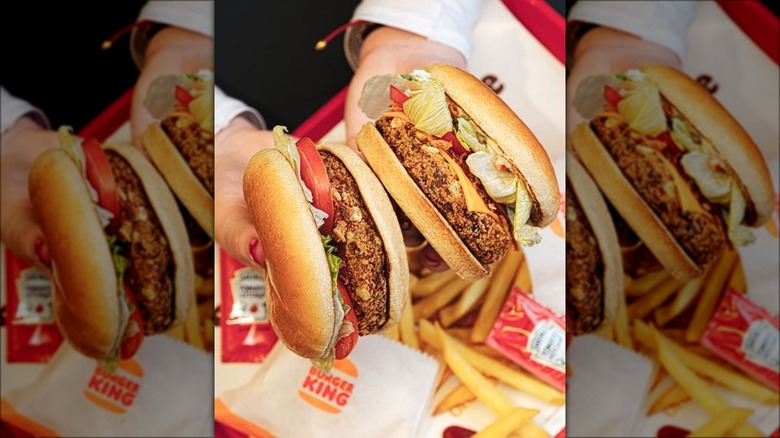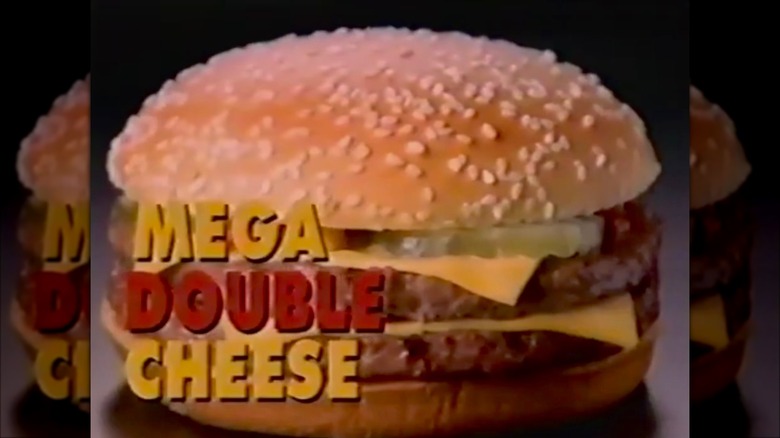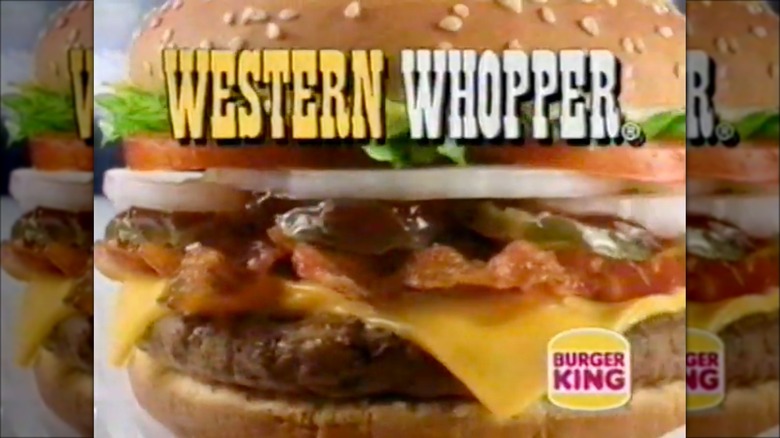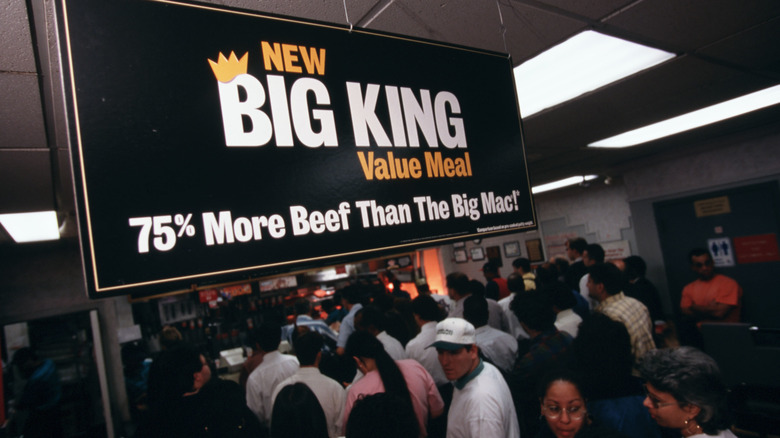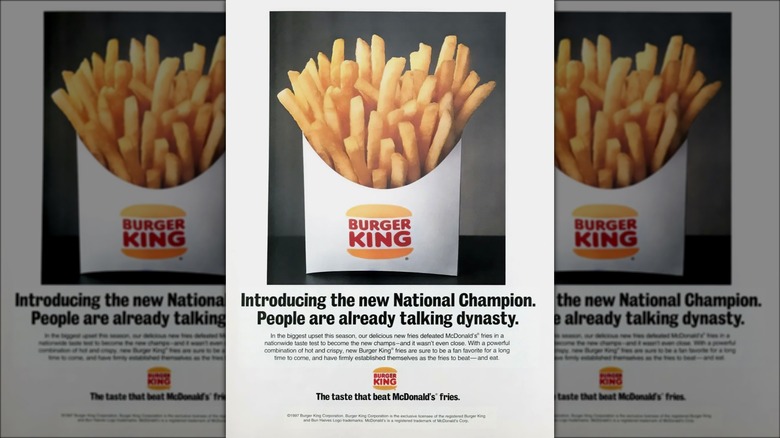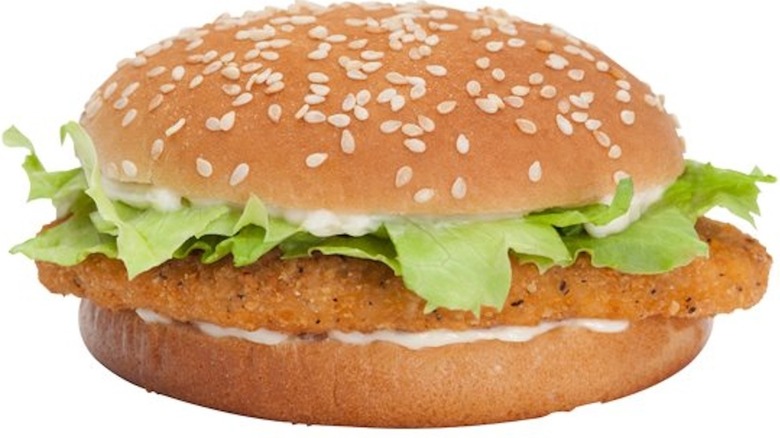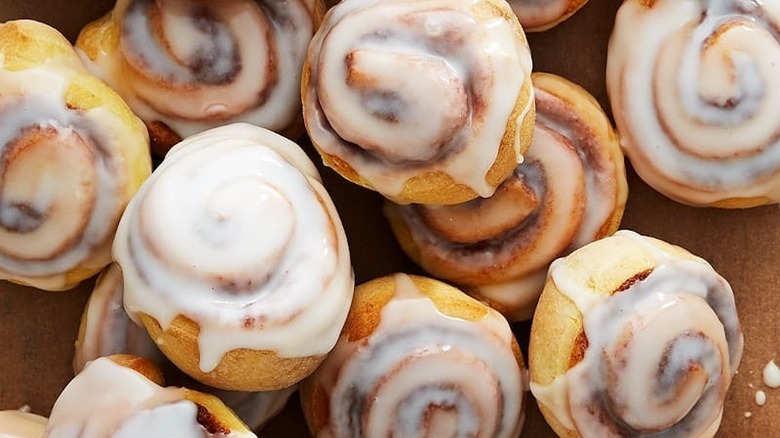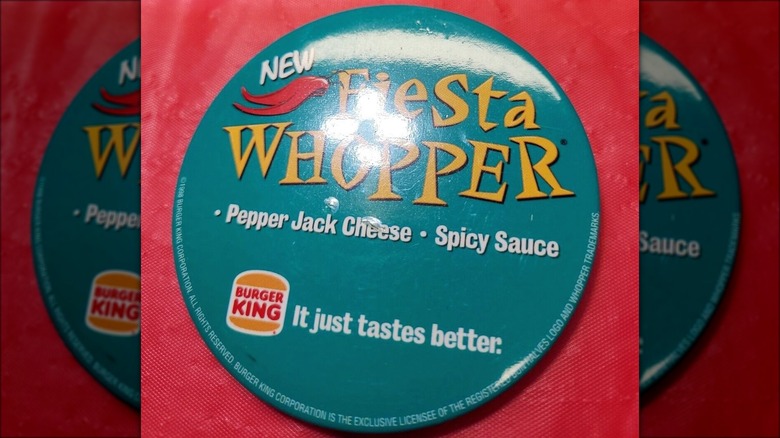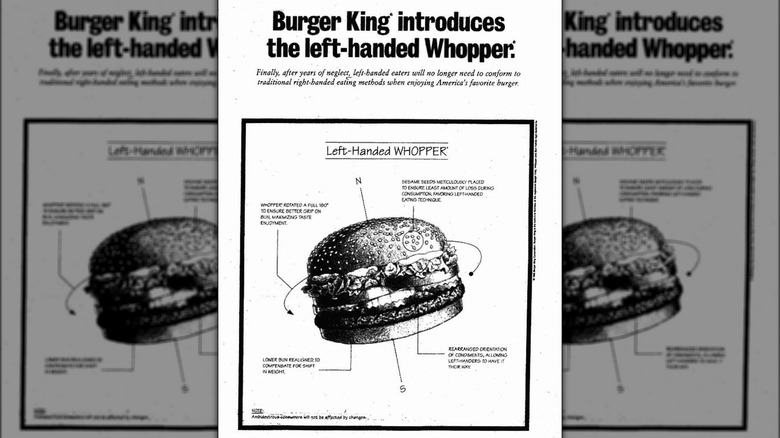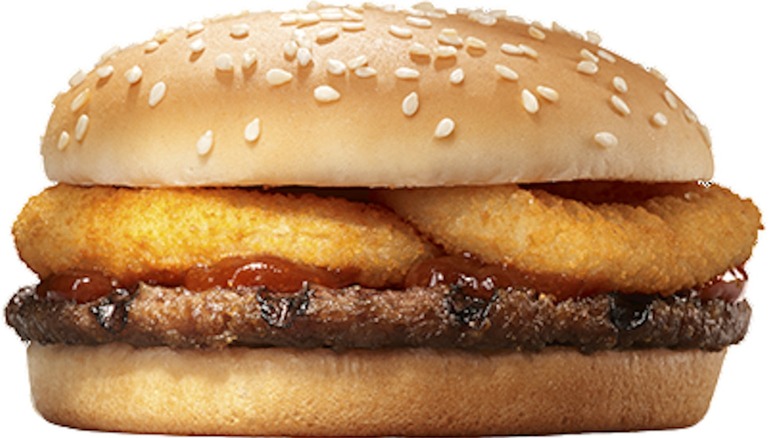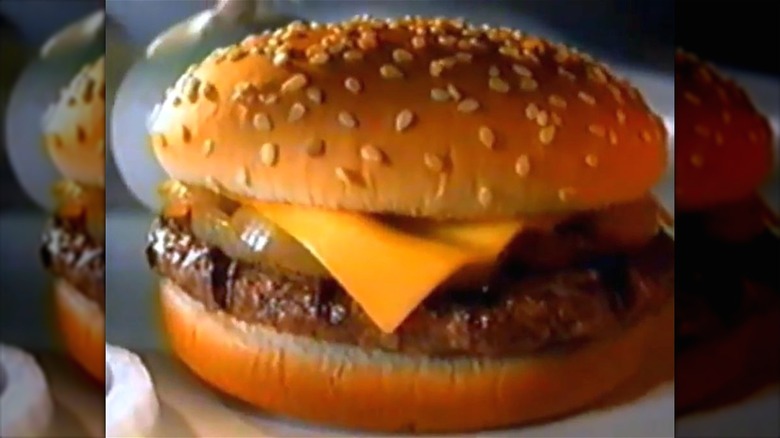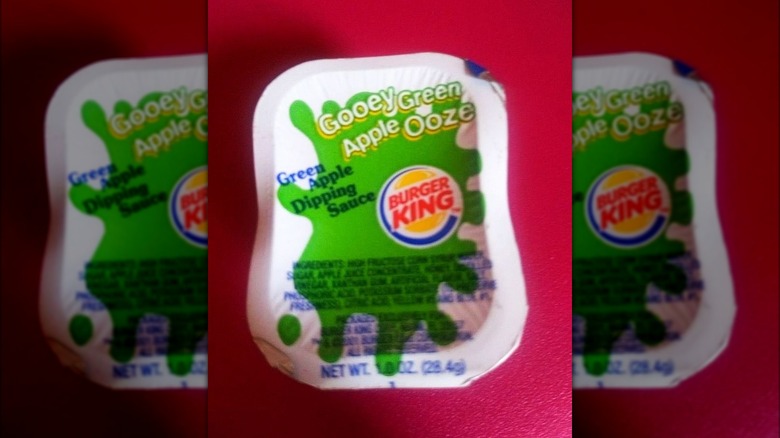19 Burger King Menu Items From The 1990s You Probably Forgot About
In the 1980s, Burger King expanded its reach and menu; it began keeping its drive-thru services open late at night and offered new morning menu items such as the Croissan'wich. As the '90s began, sales were sluggish, and new owner Grand Metropolitan P.L.C. had many ideas ready to try and turn things around. This included leaner fare, better breakfasts, bite-size bites, a wealth of whopper variations, and even the introduction of table service. Some items introduced during the last decade of the 20th century have proved to have quite the staying power, while many have collected dust as distant memories.
Let's travel back to the era when "Titanic" sank hearts, Bart Simpson exuded a lot of attitude, flannel shirts made everyone feel rather grunge, and Burger King tried almost everything and anything to lure customers to doors. Here are 19 Burger King menu items from the 1990s that you probably forgot about, in chronological order.
1. BK Broiler
Looking to make a lean profit at the expense of diet-conscious customers, Burger King rolled out a chicken sandwich option in 1990 that went by the name of the BK Broiler. However, at 550 calories and 25 grams of fat, it hardly seemed like a weight-watcher's dream. The white meat patty was baked and not fried, but still embossed with Burger King's signature grill marks. The BK Broiler was topped with lettuce, tomato, and ranch dressing, and placed between an oat-covered bun. Within a month of its launch, 1 million of them were being sold a day.
BK Broiler fans included Patrick O'Connell, famed chef of the Inn at Little Washington restaurant. The menu item's good name eventually made it into the comedy of Dane Cook, as well as headlines concerning the South Korean baseball player Byung-hyun Kim. The BK Broiler had surprising staying power, but in a large menu shake-up in 2002, it was retired and replaced by the Chicken Whopper.
2. Mini Muffins
Burger King started testing a line of mini muffins in the summer of 1990, and by the fall they were added to the morning line-up nationwide. The muffins came in a trio of flavors: blueberry, lemon poppyseed, and raisin oat bran. Canadians had the additional option of a carrot nut-flavored mini muffin. The muffins were sold in six-packs for 99 cents each, and you could get a dozen for double the price. Ads featured the musician George Clinton (who sang their praises) and characters from "The Simpsons."
The muffins were deemed worthy of representing Burger King; they were donated to a college's annual scholarship gala in 1992. But not everyone loved this new morning treat. New Jersey-based Sausville Foods Inc. had previously approached Burger King in 1987 with the idea for miniature muffins. Burger King rejected the idea but then launched its mini muffin line without Sausville Foods, so the company ended up filing a lawsuit against the fast food chain.
3. Breakfast Buddy
For decades, if anyone used the phrase "Breakfast Buddy" with "Burger King," it just meant stopping by the fast food chain with a friend for a morning bite. That all changed in 1990 when Burger King introduced the Breakfast Buddy — essentially a breakfast version of the chain's Burger Bundles (slider packs released in the 1980s). But while Burger Bundles had multiple sliders, the Breakfast Buddy was one burger. This menu item consisted of a sausage patty, a folded scrambled egg, and a slice of cheese on a little bun. The small sandwich netted 255 calories and 16 grams of fat.
Advertisements for the Breakfast Buddy featured "The Today Show" weatherman Willard Scott (famously an early riser), and heavyweight boxing champ Evander Holyfield. In the latter's ad (via YouTube), the announcer asked Holyfield: "Would you pop a buddy in the mouth for 59 cents?" After downing three of them, Holyfield responded: "59 cents? Even I can't beat that."
4. Kool-Aid Kool-Pumps
While trying to make a new name for itself in the 1990s, Burger King ramped up partnerships with brands that already had solid name recognition. In doing so, "The Home of the Whopper" also briefly became the home of WeightWatchers, Snickers, Newman's Own, and even Kool-Aid. In 1991, the powdered drink mix company's Kool-Aid Kool-Pumps became a part of the Burger King menu.
Burger King's Kool-Aid Kool-Pumps were sherbet popsicles that came in two flavors — Berry Blue and SharkleBerry Fin. The SharkleBerry Fin-flavored treats were also included, for a limited time, as the dessert in the Burger King Kids Club meals. Although no longer in the Burger King fold, SharkleBerry Fin still exists as a Kool-Aid flavor.
5. Pizza Firenze
McDonald's tried several times to make McPizza a thing. Even Wendy's attempted to make pizza happen, adding it to the chain's all-you-can-eat Superbar. Then, around the same time, Burger King did the same. After trying to peddle Domino's at four South Carolina locations, Burger King gave the authentically Italian-sounding Pizza Firenze a trial run in Louisiana and California in 1991 and 1992, respectively.
Using special fast-bake ovens, Pizza Firenze pizzas were made fresh on-site. They were topped with spicy pepperoni and Italian sausage. They came in standard pizza sizes (only available after 4 p.m.) and smaller "SingleServ" ones. A print ad (via The Daily World) listed eight reasons for buyers to try Burger King's Pizza Firenze offerings — many of the reasons were price or convenience-related. But the best reason to buy it was the fact that it was a "fast pizza with slow-baked taste."
The chain also released coupons for the pizzas set to expire in December 1992. But the menu item didn't stick around long, and by 1994, the trademark for Pizza Firenze had been abandoned.
6. Italian Sausage Sandwich
Between 1991 and 1993, Burger King let an Italian Sausage Sandwich make the rounds across the country (in an elongated seeded bun). Instead of a tubular piece of meat, this Italian sausage was a flattened patty. Customers could order it one of two ways: with mozzarella cheese and marinara sauce or with peppers and onions.
One television advertisement played up the item's Italian-American bona fides. It featured two neighborly mothers — who talked in thick New York accents — bemoaning that their sons no longer eat at home since the introduction of the sandwich. Then, one of the mothers is outed as a convert when her son rolls up with a bagged Italian Sausage Sandwich with her name on it. Unfortunately, the item was not without its critics. The Tampa Bay Times noted in 1993 that the sandwich "doesn't smell or taste like Italy." At some point thereafter, Burger King bid arrivederci to this sandwich.
7. Dinner baskets and table service
In 1992, Burger King began testing table service during dinner time at 900 locations. Company spokesman Michael Evans then explained the appeal of table service to the Daily News, saying: "People like the extra attention." By October, table service was rolled out nationally. A host greeted customers and waiters wrote down their orders — which now included new Dinner Baskets (with fried shrimp, Whopper, steak sandwich, chicken filet, and meatloaf options). They also came with optional sides, like salad, coleslaw, a baked potato, or French fries. Eaters munched on freshly popped popcorn while waiting for their Dinner Baskets to arrive.
The novelty wore off by the spring of 1994 when the waiters, popcorn, and baskets were all tossed into the wastebasket. Ron Paul, president of restaurant consulting firm Technomics, summarized the failed experiment to The Miami Herald: "In the consumer mind, Burger King sells burgers, not shrimp."
8. Spicy Bean Burger
In 1990, Burger Kings in England launched a Spicy Bean Burger. Two years later, it was imported to America for a six-month test run at a single location in Watkins Glen, New York. This new meat-free burger combined the talents of kidney beans, carrots, onions, potato flakes, and peppers. At $2.29, it was a small price for customers to pay. But the burger had the company seeing red, as they had to import the patties at the high cost of about $150 per case.
Still, a Watkins Glen animal rights group applauded the move. One of its employees, Patricia Chilbert, described it to The Democrat and Chronicle, saying: "It's real spicy, like a taco taste." Chilbert's 7-year-old grandson was less than complimentary, simply calling it "blech."
The owner of the New York Burger King hosting the Spicy Bean Burger told The Jackon Son (via The Associated Press): "The demand is unbelievable. People are coming from all over. There's not a seat in the restaurant." The enthusiasm didn't readily extend beyond Watkins Glen, as it never launched nationwide. But a similar item, the Ultimate Bean Burger, returned to U.K. menus in early 2024.
9. Mega Double Cheese
Looking to freshen up its double cheeseburger, Burger King doubled the meat. The mammoth-sounding Mega Double Cheese now included a ⅓-pound of beef split between the two patties. The main television ad for the item –which aired during hit shows like CBS's "Northern Exposure" – featured a group of welders. In it, the narrator described the Mega Double Cheese as "one new burger that eats like two," (via YouTube).
Two flame-grilled patties, two cheese slices, pickles, ketchup, and mustard were sandwiched between a sesame-seeded bun to make the Mega Double Cheese. It launched for $1.99, so the TV ad noted: "Since the burger got bigger, the value did, too." This double burger was eventually exported overseas; the United Kingdom got its first taste starting around 1996.
10. Western Whopper
Burger King burgers are no stranger to barbecue sauce — that includes the Bacon, Barbecue Sauce, and Cheese "Hot Topper" that joined the line-up in 1987. Eight years later, Burger King upped the ante by roping in customers with its Western Whopper.
The Western Whopper piled cheddar cheese, hickory-smoked bacon, and barbecue sauce on top of the usual Whopper ingredients. During its launch, employees wore buttons with "Howdy" written on them, hoping to drum up a few more sales of the $1.99 offering. A Sioux Falls, South Dakota location even ran a promotion that distributed free tickets to a local basketball game with the purchase of a Western Whopper. The Hickory Smoked Whopper — which launched the following year — was similar, aside from not including barbecue sauce. In 2007, after years away, the Western Whopper returned with a mustachioed advertisement imploring viewers to "bring out your inner cowboy" (via YouTube).
11. Big King
”People can only eat so many Whoppers,” the company's North American president, Paul Clayton, relayed to The New York Times in the '90s. Burger King's realization that customers needed a change of pace led the chain outside its doors, and over to McDonald's for a Big Mac. In 1997, Burger King introduced its take on the Big Mac: the Big King.
This copycat featured two 2.8-ounce flame-broiled beef patties that dwarfed the Big Mac's 1.6-ounce ones. The Big King was rounded off with lettuce, cheese, pickles, onions, and a special King Sauce stacked between two buns. McDonald's countered this move when it introduced the Big N' Tasty that same year.
By 2001, the Big King was replaced with the similar King Supreme. The Big King briefly returned in 2020 (as the Big King XL). The Big King can still be found internationally, like on Burger King menus in Estonia.
12. New French Fries
In an attempt to finally dethrone McDonald's and its beloved golden French fries, in 1997, Burger King shook up its fry recipe. The new spuds were freshly cut, precoated with potato starch, frozen, and eventually fried in stores. The result was a thicker fry that could stay hot longer than the previous iteration and happened to cost more to produce. A marketing budget of $70 million helped push the new Burger King fries far and wide. The promotional campaign even enlisted the help of the character Mr. Potato Head and the musician Isaac Hayes.
Reviews of the new fries were mixed. Even though Rosie O'Donnell approved of their crispiness, these fries eventually became a forgotten noble experiment. By 2011, Burger King changed its French fries recipe along the same lines. Once again, the fries were designed to be thicker, tastier, and hotter.
13. Chick'n Crisp Sandwich
In 1998, Burger King rolled out a new value menu called the 99-Cent Great Tastes Menu. That same year, the new Chick'n Crisp Sandwich joined the likes of a Whopper Jr. and a 5-piece Chicken Tenders on that menu. This simple sandwich consisted of a piece of fried, white-meat chicken with just mayo and pickles for toppings. Later, lettuce joined the sandwich. In print advertisements (via the Argus-Leader), the value of the Chick'n Crisp Sandwich was described as: "Big chicken taste (chicken little price)."
The Chick'n Crisp Sandwich began as a limited-time-only item, but soon earned permanent menu status. It hung around on American menus until at least 2012. The name Chick'n Crisp Sandwich lives on at Burger King locations in Malaysia.
14. Cini Minis
During the '90s, the Pillsbury Company and Burger King were sister companies owned by the same parent company (Grand Metropolitan P.L.C.). It made perfect business sense then, for the two food giants to help each other out.
In 1996, Pillsbury supplied biscuits for Burger King. Two years later, the two businesses hoped to make a lot of dough with a new morning creation for the fast food chain: Cini Minis. For 99 cents, a customer would get a quartet of miniature cinnamon rolls with a side of icing (to use as a dipping sauce). Ads featured the Pillsbury Doughboy working long nights to prepare them for the morning. Twenty years after its debut, Burger King brought back the beloved treat for a limited time only, with its sticker price increased to $1.49. Perhaps one day the Cini Minis will rise again.
15. Fiesta Whopper
In 1998, Burger King created a cause for celebration with the release of a new burger called the Fiesta Whopper. The menu item's tagline was: "It's the taste you're burning for" (via YouTube). Its release came with commercials featuring such pulsating hits as Donna Summer's "Hot Stuff" and Gipsy Kings' "Bamboléo."
This Whopper's main attraction was pepper jack cheese and a spicy sauce. When combined, these ingredients made it look like the bun was smothered in pimento cheese. Even the fries got in on the fiesta, and the chain offered an optional seasoning packet of Fiesta Sprinkles that could be applied to the spuds. These days, "Fiesta Whopper" is a term reserved for a general Whopper celebration, but the menu item is no longer around.
16. Left-Handed Whopper
In 1998, Burger King placed a full-page advertisement in USA Today introducing a new "Left-Handed Whopper." This revolutionary Whopper was rotated 180 degrees to better assist left-handed eaters. There was even some fine print in the advertisement explaining that these changes wouldn't affect ambidextrous customers. However, the real fine print could be found in the upper right-hand corner of the paper, where the date read: "April 1."
This Left-Handed Whopper ended up being one of the greatest food-related April Fools' jokes ever, as curious eaters showed up at Burger King looking for the specially made item (which was just a normal Whopper). Kim Miller, a Burger King spokeswoman, then told The Tampa Tribune (via The Associated Press): "Our customers have been playing along with this, asking for left-handed food." While many fell for it, the Left-Handed Whopper never became an official part of the menu.
17. Rodeo Burger
Burger King seemed to be the destination for Wild West-themed burgers in the '90s. Three years after the Western Whopper galloped into stores, the Rodeo Burger rode into town screaming "Yeehaw!"
A burger can't be considered Western unless it's saddled in barbecue sauce. The Rodeo Burger followed this logic, with its sauce provided by Bull's-Eye. But this 99-cent offering differed from the Western Whopper in one way; it came stuffed with a few of Burger King's onion rings.
The Rodeo Burger was used to help promote the film "Small Soldiers." Ads even featured the character Chip Hazard from the movie in a courtroom setting, riffing on "A Few Good Men." As Hazard is being escorted out of the room, he tells a military policeman: "You can't handle the Rodeo Burger" (via YouTube).
18. Cheese'n Onion Melt
Patty melts are one of the best cheeseburger variants ever invented. In these delicious burgers, melty cheese covers a pile of caramelized grilled onions. One of Burger King's first attempts at the patty melt had a fun name and a low price point. Before the '90s came to a close, the Cheese'n Onion Melt joined the 99-Cent Great Tastes Menu for a limited run.
In lieu of holey Swiss cheese, the Cheese'n Onion Melt skewed more local, oozing with a slide of American cheese. The burger was 2.8 ounces and outputted 380 calories and 19 grams of fat in its tiny frame. It would take more than two decades for Burger King to melt eaters' hearts again with the introduction of a new line of patty melts in 2023.
19. Apple Green Slime Dipping Sauce
The "Ghostbusters" franchise popularized green slime in the 1980s. The torch was carried on by the children's television channel Nickelodeon in the following decade. In 1998, Nickelodeon released a green slime popsicle. A year later, it tested the limits of condiments when it teamed up with Burger King to unleash Apple Green Slime Dipping Sauce.
The sauce could be found in Burger King's Kids Club Meal, alongside chicken tenders and toys like a "splat" calculator, just in time for the new school year. If anyone was curious if kids would eat it, columnist Ken Hoffman (also known as The Drive-Thru Gourmet) bared witness. Hoffman wrote in Florida Today that his son was eating everything with the sauce, noting that the child even "picked up the packet of Slime and slurped it like he was eating raw oysters." In 2001, Burger King went green again, but this time around, with green Heinz Ketchup packets.
